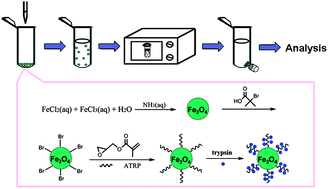The effort to stabilize enzymes and improve their activity has generated great interest because of their wide application in proteomics research, bioenergy conversion, bioassays and so on. In this work, biocompatible reactive polymer, poly (glycidyl methacrylate), grafted from magnetic nanoparticles by atom transfer radical polymerization method, has been firstly proposed to immobilize enzymes for microwave-assisted digestion. Meanwhile, trypsin was chosen as a model enzyme. Resulting from the increased functionality, the immobilization amount of the enzyme on the magnetic nanoparticle surface has been greatly improved. Furthermore, the enzyme immobilized magnetic nanoparticles have exhibited excellent repeatability and stability. The influence of the polymer chain length on digestion efficiency has been investigated both at 37 °C and under microwave. It has been found that the digestion efficiency increases with the lengthened polymer brushes due to the increased immobilization amount. Utilizing cytochrome C as a model protein for digestion, the performance of this immobilized biocatalyst has been demonstrated and this digestion assisted with microwave could be completed within 15 s. This study offers insight into the design of polymer brushes on the surface of magnetic nanoparticles for high digestion efficiency in the future.

You have access to this article
 Please wait while we load your content...
Something went wrong. Try again?
Please wait while we load your content...
Something went wrong. Try again?


 Please wait while we load your content...
Please wait while we load your content...